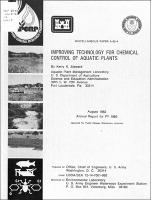Please use this identifier to cite or link to this item:
https://hdl.handle.net/11681/6276| Title: | Improving technology for chemical control of aquatic plants |
| Authors: | Steward, Kerry K. |
| Keywords: | Aquatic plant control Aquatic weeds Chemcontrol Chemical control Herbicides Aquatic Plant Control Research Program (U.S.) |
| Publisher: | U.S. Army Engineer Waterways Experiment Station |
| Series/Report no.: | Miscellaneous Paper (Aquatic Plant Control Research Program (U.S.)) ; no.Miscellaneous Paper A-82-4 |
| Abstract: | Because a need to modify existing aquatic herbicide evaluation techniques was recognized, it was decided during an interagency workshop in November 1979 that uniform procedures should be established to facilitate interlaboratory comparisons among Federal agencies. A protocol describing procedures for evaluating conventional and controlled-release herbicides was developed and tested during FY 1980. Progress on the implementation of the protocol and the results of the conventional herbicide evaluation program are discussed in this report. During FY 1980 the following compounds were evaluated in the laboratory: three controlled-release formulations, one coded-confidential compound, one growth retardant, and six conventional herbicide formulations. Moreover, iron chelates were evaluated for enhancing efficacy of diquat and potassium endothall against hydrilla. The release of 2,4-D from the MOE/GMA copolymer in a flowing water environment following an initial application rate of 0.01, 0.025, 0.05, 0.10, and 0.25 mg/l was linear and predictable over a 70-day period. Moreover, when 2,4-D was applied at the rate of 1.2 mg per gram of polymer per day to Eurasian watermilfoil, essentially 100 percent control was observed on two of the four replicate treatments by 8 weeks posttreatment. This compound was found to be efficacious in consistency of release and in producing phytotoxicity over an approximate 4-month period. Dichlobenil release from a beeswax controlled-release system was not constant. Microscopic examination of the pellets revealed an accumulation of the crystalline dichlobenil near the surface, which may account for the rapid and inconsistent release of the dichlobenil. Two of three controlled-release fenac formulations were effective against hydrilla at a 1.0-mg/l treatment rate in 10 weeks and against Southern naiad at a 1.0-mg/l treatment rate in about 8 weeks. No control using the fenac formulation was apparent against cabomba. Eurasian watermilfoil control was similar to that of conventional fenac formulations, i. e. 16 weeks at 0.5-mg/l treatment rates. The coded compound (RO 3-7042) from MAAG Agrochemicals was effective against hydrilla over 16 weeks at a 1. 0-mg/l treatment rate and against Southern naiad in about 8 weeks at a 5.0-mg/l treatment rate. No control was observed against cabomba. Eurasian watermilfoil control was observed after 16 weeks at a 0.5-mg/l treatment rate. This coded compound was not effective against duckweed; marginally effective against waterhyacinth; but very effective against waterlettuce at a 1.0-kg/ha treatment rate. A growth retardant (EL-507) from Elanco Research Laboratories was found effective against waterhyacinth at a 1.0-kg/ha treatment rate. Additional studies on its effects on other aquatic plants appear warranted. |
| Description: | Miscellaneous Paper |
| Gov't Doc #: | Miscellaneous Paper A-82-4 |
| Rights: | Approved for public release; distribution is unlimited |
| URI: | http://hdl.handle.net/11681/6276 |
| Appears in Collections: | Miscellaneous Paper |
Files in This Item:
| File | Description | Size | Format | |
|---|---|---|---|---|
| MP-A-82-4.pdf | Miscellaneous Paper A-82-4 | 3.3 MB | Adobe PDF |  View/Open |